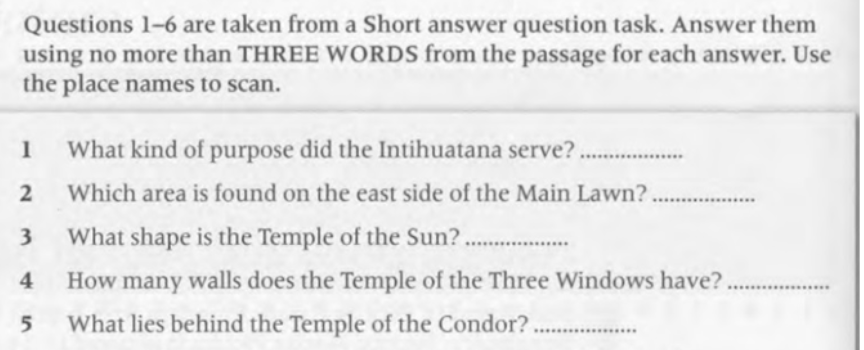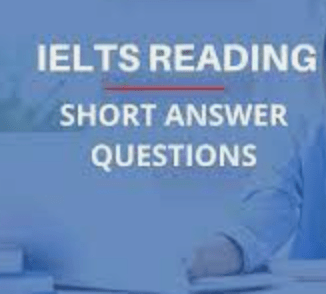Hôm nay các bạn cùng mình tìm hiểu dạng bài Short Answer trong IELTS Reading nhé. Đây là dạng bài không quá khó nhưng cần luyện nhiều và chú ý các gợi ý dưới đây nhé.
1. Short Answer là dạng câu hỏi gì?
Short Answer là dạng bài trả lời câu hỏi, tức đề bài sẽ đưa câu hỏi và nhiệm vụ của bạn là trả lời. Tuy nhiên không phải muốn trả lời sao cho đúng là được, mà đề bài sẽ giới hạn số từ để trả lời. Ví dụ chỉ được trả lời trong “One word” là 1 từ mà thôi. Nhìn chung dạng bài khá ít gặp trong IELTS Reading (ít gặp hơn những dạng bài khác).
Theo mình đây là dạng khá giống “Completion” là điền từ, chỉ khác là thay vì đục lỗ để các bạn điền vào. Thì họ làm thành 1 câu hỏi để mình dễ tìm thông tin cho câu trả lời hơn. Nhìn chung đây là dạng bài không khó, dễ lấy điểm nếu làm cẩn thận.

Cách làm bài mình sẽ nói bên dưới, các bạn nhìn sơ qua dạng bài nhé!
Xem Thêm: Sharpen your IELTS Reading Skill Matching Features
Sharpen your Multiple Choice Trong IELTS Reading Skill
2. Cách làm bài Short Answer
Bước 1: Khoanh tròn số từ cần điền
NO MORE THAN TWO WORDS AND/OR A NUMBER nghĩa là number = one Word. Khi bạn gặp dạng câu hỏi này, một số (number) được tính là một từ.
Thường mình thấy trong IELTS Reading sẽ hay cho “One word and/or a number” để bạn có thể trả lời 1 từ. Hoặc nếu câu hỏi là “When” thì bạn có thể trả lời 1 số. Ví dụ như “1998”.
Những câu bạn đã spot được câu trả lời rồi, câu trả lời của bạn gồm 2 từ, ví dụ như “red bottle”, mà đề bài chỉ cho điền “one word” thì theo mình bạn nên lược bỏ bớt 1 từ không quan trọng trong đó. Ví dụ như trong cụm trên là “red”, chỉ điền vào “bottle” thôi vì red mang tính miêu tả cho sự vật.
Nhưng có những trường hợp lại loại bỏ sai mất từ cần điền đó nhé, nên bạn hãy luyện tập thật nhiều để biết cách ra đề của IELTS Reading và cách IELTS cho đáp án thường sẽ như thế nào!
Bước 2: Khoanh tròn từ để hỏi + Dự đoán trước câu trả lời
Chúng ta sẽ một số từ để hỏi basic như 5W – 1 H: Why, what, where, when, who và how. Nhưng khi nhìn những câu hỏi trong bài thi, chúng ta nên khoanh những gì cụ thể hơn như thế, ví dụ như bài bên dưới, một số từ cần chú ý là
1. What, African rhinoceros, compared
-> Thì cần trả lời “thing” mà African rhinoceros được so sánh với
2. Which type, fell in number, below a hundred
-> Thì cần trả lời “loài” tê giác nào giảm số lượng còn dưới 100 con
3. What percentage, black rhinos, illegally killed, 1992
-> Tìm trong bài năm 1992, trả lời “số phần trăm” mà tê giác đen bị giết một cách phi pháp
Bước 3: Check lại đáp án
– Check lại xem đáp án của mình có cần mạo từ “a” hay “the” “The” không, ví dụ a book, the park, The Secret Garden (tên riêng của sách), nếu có thì mạo từ cũng được tính là ONE WORD, cho nên phải kiểm tra lại độ cần thiết và yêu cầu đề bài về số lượng từ cần điền. Và như mình đã nói ở trên giống như “red” là một ví dụ đó.
– Kiểm tra xem có cần “s” hay không, hãy học bảng những danh từ đếm được số nhiều, danh từ không đếm được, danh từ không thể thêm “s” được, danh từ/ cụm danh từ bắt buộc luôn phải có “s”.
– Thường các bạn nên copy paste y chang từ bài đọc qua nên đảm bảo rằng bước “copy paste” của mình không bị sai chính tả, không thiếu s, không thêm bớt gì nhé!
Free Test and Practice with IELTS.TOOLS
3. Luyện tập – Short Answer trong IELTS Reading
Sensory Overload
A Are you suffering from a feeling of annoyance? Does life seem to get more and more irritating all the time? Do you struggle day to day just to stay calm and clear-headed in the face of more and more frustrating experiences? If your answer to these questions is “YES,” you are not alone. In fact, you are part of a growing trend that demonstrates the significance of the small events which annoy us on a day to day basis.
B According to psychologist Maurice Penman, inhabitants of today’s modern cities face a far more aggressive range of sensory experiences than ever before. “It is not simply that the pace of life is faster in today’s world, or that people are under more pressure at work. Of course, both those things are true. But today people are exposed to a greater number of both visual and auditory stimuli. Basically, this means we are being asked to both look at and listen to far more than we ever have been before.”
C However, Penman is quick to point out that many of the things which are contributing to these problems are also the same things many of us value. A greater sense of irritation is the price we pay for the convenience of the Internet and mobile phones. “Mobile phones are a very significant example to consider. There is no doubt that they are useful in a multitude of ways, and most people do not want to go back to the days before them. But at the same time, mobile phones have almost completely destroyed a sense of quiet public space. There was a time when you could rely on public transport being relatively quiet, a place to think about the events of the day on the way home. Now a bus or a train carriage can feel like being locked in a busy office.”
D The increase in sensory demands is not just due to the use of mobile phones. Advertisers are reaching out to potential consumers more aggressively than ever. News services are now broadcast on buses and at train platforms. Family meals are frequently interrupted by telephone canvassers and email users are often forced to deal with an avalanche of unsolicited promotional messages, or “SPAM”. One could easily imagine that our children and their children may have to guard their homes from an overwhelming amount of annoyance
E While it is difficult to deny the growth in these increasingly annoying events in our day, is there actually any real significance to these facts? Penman argues: “There is no doubt that on the surface, this increase of stimuli in our day simply appears to be a matter of minor annoyance. But when we look closely, we can see that this has the potential to significantly affect our psychological health.” He goes on to explain that if exposure to these irritations is frequent and prolonged, very subtly our stress levels begin to rise. As they do, we find there is a compound effect. Stress from the minor episodes in the day starts to increase our feeling of pressure when faced with major challenges at work. We are increasingly carrying a greater and greater stress load, with opportunities to relax and unwind more and more restricted. Penman points out that even though we all sometimes crave stimulation, we have become so obsessed with it in the twenty-first century that it has now become almost impossible to avoid. Shops increasingly feel the need to play loud, thumping rock or techno music. Advertising becomes more and more energetically aggressive all the time. This, Penman maintains, prevents us from dealing with our daily stress and eliminating it from our systems. He adds: “You really do need to get right out of the city and into a quiet space now, though most of us are too busy to do that very often.”
F It might be easy for critics to dismiss the annoying experience of too many mobile phones on the bus, or any of the other stimuli Maurice Penman cites. However, it is the failure to eliminate stress which leads to potentially fatal consequences. If these daily distractions are contributing seriously to our stress levels, then Penman has identified a significant danger. We now know that stress truly is a killer, and has been implicated in the rise of depression, heart disease and even weight problems, as it increases hormones in the body which stimulate the appetite for fattening carbohydrate-rich foods.
G There is no denying that Maurice Penn’s main arguments are compelling. It seems that stress has become so prevalent that people are getting stressed about their levels of stress. But what are we supposed to do? He suggests we do everything we can to go within ourselves and try to maintain a sense of personal peace and space. He recommends the use of meditation and relaxation tapes, exercise at the end of the day whenever possible and greater emphasis on fun. Unfortunately, Maurice Penman had no suggestions for those of us who find meditation frustrating, or who get annoyed at relaxation tapes. He had no recommendations for days when you can’t find any equipment you need in the gym, or find yourself irritated at those around you who keep saying you need to have more fun.
Questions 25-27
Answer the questions below using words from the passage. Write NO MORE THAN THREE WORDS for each answer.
Write the correct answers in boxes 25-27 on your Answer Sheet.
25 What word is used to describe how advertising has become?
26 What does stress make you want to eat?
27 What does Penman believe people should place more importance on in order to relieve stress?
KEY ANSWER
25 aggressive
26 fattening food
27 fun

